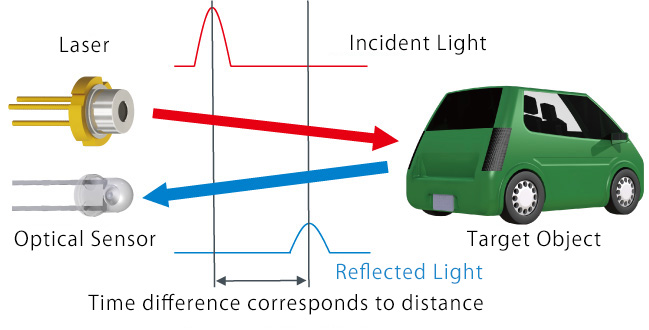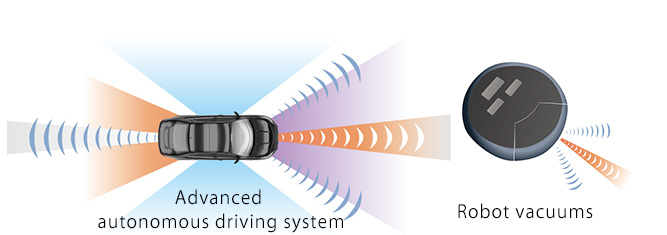LiDAR
What is LiDAR?
Short for Light Detection and Ranging, LiDAR is a remote sensing method that irradiates objects using near-infrared, visible, or UV light then detects the reflected light with an optical sensor to measure the distance.
Also called Laser Imaging Detection and Ranging, it is often used to measure the time lag between pulses of near-infrared laser light bouncing off a target object.

LiDAR is characterized by being able to not only accurately detect the distance to a target object, but also its position and shape.
LiDAR Application Examples
One of the first things that come to mind when thinking about the use of LiDAR technology is in advanced autonomous driving systems in vehicles. In fact it is believed to be an essential technology for achieving fully autonomous driving (Level 5).

Other applications include robot vacuums and golf rangefinders in the consumer sector and automated guided vehicles (AGVs) and service robots in the industrial sector that require high accuracy detection of people and objects.
Advanced autonomous driving system
In ADAS (Advanced Driver Assistance Systems, comprised of automatic braking, lane keep, and other functions), the use of cameras and millimeter radar systems have become mainstream. However, combining 3 systems by including LiDAR is required to achieve autonomous driving.
To configure an advanced autonomous driving system, it is necessary to utilize the strengths of each method to compensate for their respective weaknesses so that nothing is missing.
| Camera | Millimeter Radar | LiDAR | |
| Method | Identifies objects from images captured by cameras | Utilizes radio waves to detect distance and direction by measuring the time lag as the waves hit and reflect off an object | The time difference of laser pulses reflecting off the target object is measured to determine the distance, position, and shape in 3D |
| Advantages |
|
|
|
| Disadvantages |
|
|
|
Laser Diodes for LiDAR
To improve LiDAR sensing performance (i.e. longer sensing range, higher spatial resolution), laser diodes, which act as the sensing light source, are required to deliver higher output and efficiency along with smaller beam size.
ROHM can propose laser diodes that meet these demands.




